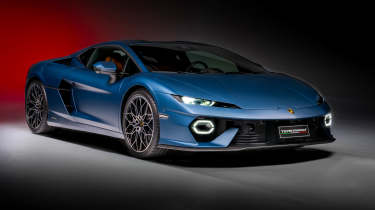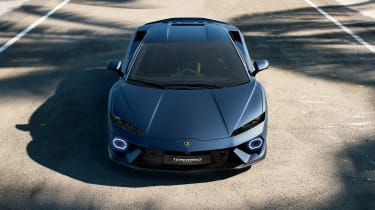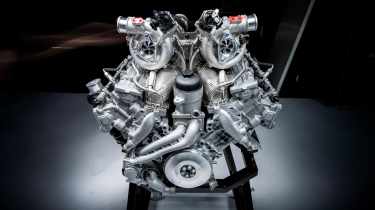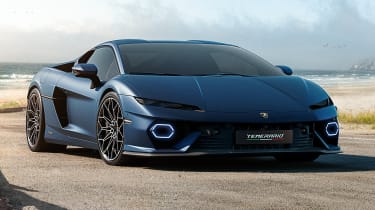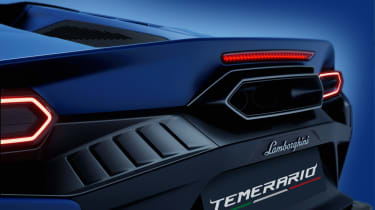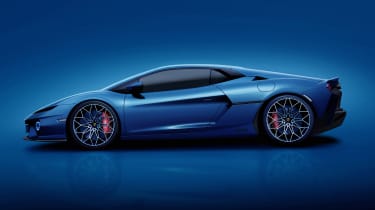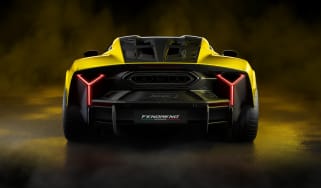Lamborghini Temerario priced from £260,035
On sale in 2025, the Temerario will start from £260k, rising to over £290k with the Alleggerita package
Lamborghini knows exactly how worried the Huracán-faithful are about whether the Temerario, with all its power (over 900bhp) and revs (up to 10,000rpm), will push the same emotional buttons as the old naturally aspirated howler. From Temerario Line Director Paolo Racchetti to Chief Technical Officer Dr Rouven Mohr, the message being drilled home during the Lamborghini Temerario’s UK debut was that we can expect a characterful, exciting, charismatic engine to take the place of the beloved V10.
The power and torque curves that Mohr detailed were certainly impressive, the electrified mill giving everything all the way up to 10,000rpm, unlike some turbocharged engines that tail off some way short of the limiter.
‘The decision to go with a turbo engine was obvious,’ Mohr explained. ‘The power level in this segment has increased dramatically, so another naturally aspirated engine, with future emissions regulations, it would be nearly impossible.
‘But the guideline for the entire design of the engine, from scratch, was character. We said if we do this, we have to make sure that this engine has a unique character – as close as possible to naturally-aspirated, to a race engine.
‘What is clear that coming from the V10 engine, sound expectations are high. So important for us is the sound. This flat crankshaft combined with turbo and 10,000rpm, it’s giving an outstanding behaviour, especially starting from 7000. The engine really starts to scream, a little bit like a motorcycle.’
The Huracán sold almost 30,000 units and it owes that success in part to just how frequently it evolved to stay fresh, fill different niches and enhance the experience. From the STO, a road-going racer, to the Sterrato, a supercar made for off-roading, it’s a mighty family of cars dedicated to the thrill of driving in almost all forms. So, it stands to reason, the Temerario ought to follow suit. What else is to come? Is this engine wedded to all that hybridity, or could a Temerario RWD be possible?
‘It’s clear that in parallel we are developing the GT3 car and for sure these cars will not have hybrid and will have smaller turbochargers,’ Mohr said.
‘For the street car, if you want to reduce the electrification content and remove the front e-axle, it’s possible. It’s something we thought about at the beginning, that from the technical side, there are a lot of possibilities.
‘If you start a project, you have the entire life cycle. We have a baseline in our portfolio. I would not say we’re going for a one to one copy of the Huracán life cycle. The derivatives would have to fit the character of the car. Some versions of the Huracán would not fit the Temerario. And we as a brand, we always want to surprise. The Sterrato was a surprise but if we do one for this car, we did that already. We are always looking for something unexpected. On the other versions, you can be excited looking for something unexpected.’
There’s certainly power on the table to be had, in any case. When asked what the ceiling for the V8 was, while declining to give exact figures, we were told that ‘you can be sure, it’s a four-digit number’. Between the Lamborghini Temerario and the new Chevrolet Corvette ZR1, this really is an incredible new era of potency for high-performance turbocharged V8 engines.
Lamborghini Temerario in detail
The Temerario is the successor to the Huracán and the second model in Lamborghini's High Performance Electrified Vehicle lineup after the Revuelto. Launching as a rival to the Ferrari 296 GTB, over a decade since its popular and profitable predecessor arrived, it has an awful lot to live up to.
It will be priced from £260,035 for the base car, with the lighter, more track-focused Alleggerita version set to be priced from £297,235. Without accounting for options, that makes an Alleggerita spec Temerario a full £85k more expensive than the Huracán Tecnica it replaces. The Temerario is also a litte bit more expensive than its chief rivals, the Ferrari 296 GTB and McLaren 750S, which both start closer to £250,000. That said, with over 900bhp, it’s a fair bit more powerful too.
Downsizing and electrification are ordinarily associated with efficiency rather than performance, but the Temerario moves the game on in both respects. Its smaller-capacity hybrid-assisted engine has been meticulously engineered to deliver the kind of intoxicating driving experience we’re used to from Lamborghini, while comprehensively outgunning its predecessor in terms of raw speed.
Stephan Winkelmann, Chairman and CEO of Lamborghini, said: 'Every new Lamborghini must surpass its forerunners in performance terms, while at the same time being more sustainable from an emissions standpoint. With the Temerario, we have completed a key chapter in the electrification strategy included in our Direzione Cor Tauri plan: we also become the first luxury automotive brand to offer a completely hybridized range.'
Engine, gearbox and performance figures
While it's common for manufacturers to develop their hybrid powertrains around existing combustion engines, the Temerario is different. Mounted at its core is the result of five years of painstaking development: the ground-up designed L411 V8. While its cylinder count is lower than its predecessor, its specs certainly are a different matter.
Output of this new 4-litre 180-degree V8 stands at 789bhp to put it 158bhp ahead of the most powerful Huracán, but raw power isn’t where its USP lies. This figure is achieved at between 9000 and 9750rpm, with the redline not coming until 10,000 – 500rpm higher than in the Revuelto. This is achieved through the use of a flat-plane crank and high-tech components such as titanium conrods and 11,000rpm-capable finger followers, parts you’d usually expect to find on a Le Mans racer. To help provide torque at such high revs, a pair of huge turbochargers supply over 36 PSI of boost at peak load, 1.4 PSI more than even the McLaren P1.
With an incredible specific output of 197bhp per litre to its predecessor’s 121, managing the heat generated by the new powertrain isn’t easy. With such tight packaging, the use of forced induction and hybrid assistance, the Temerario has required a significant boost in cooling performance to maintain its performance, so Lamborghini’s engineers have developed a new radiator layout to boost cooling efficiency by 30 per cent.
As if its new V8 wasn’t enough, the Temerario has also been equipped with a plug-in hybrid system, but pure-electric running isn’t its primary purpose. While a 3.8kWh battery pack mounted within the central tunnel does allow for zero-emissions running, the goal of the triple-motor hybrid setup is to improve dynamics and mimic the response of a naturally-aspirated engine.
Each of the three motors produce 110kW (148bhp) and 221lb ft of torque, with two mounted on the front axle for a 220kW (295bhp) combined peak; the third is sandwiched between the engine and transmission, much like the Revuelto flagship. Lamborghini’s engineers have been given more flexibility than ever to manipulate dynamics through torque vectoring with this pure-electric front axle, with the third motor providing torque fill, all but eliminating turbo lag, acting as a starter motor and to regenerate power. Accepting a 7kW charge, the battery takes 30 minutes to fill when plugged in, but can also be topped up via regenerative braking or the V8 engine, with the latter taking only six minutes.
Transferring this power to the ground is a seven-speed dual-clutch transmission, and while the Temerario’s ‘box weighs less than that in the Huracán, it achieves quicker shift times. This is thanks to the use of a trick hollow shaft that allows the same synchronisers to be used for different gear torque paths, saving weight and reducing dimensions. Unlike some hybrid vehicles which use the electric motors for this function, it also comes with a mechanical reverse gear.
The result of all of this is a stunning 907bhp peak output (just 94bhp behind the blistering Revuelto and 4bhp ahead of the McLaren P1), peak torque of 538lb ft and some predictably brisk performance figures. Standstill to 62mph happens in 2.7sec with top speed at a quoted 213mph, half a second and 11mph ahead of the original LP610-4 Huracán. All of this is even more impressive when you consider its weight gain, with a 1690kg dry weight a whole 268kg heavier than the original Huracán. The Temerario’s 537bhp/ton (dry) power-to-weight figure is impressive nonetheless, standing 114bhp/ton ahead of its predecessor.
What does it sound like?
One raging bull-shaped elephant in the room is the Temerario’s sound. The Lamborghini V10 has become one of the most recognisable sounds in the automotive world, on and off the circuit. Ensuring an engine of a lower displacement with few cylinders and forced induction can evoke at least some of the same emotions for the driver and everyone within a 2-mile radius is certainly not an easy task. Thankfully, our time with a pre-production prototype suggests they’ve done a good job. Listen to its sound here.
A hybrid starter-generator startup sound akin to a McLaren P1 is strange to hear coming from a Lamborghini, but meticulous tuning of exhaust harmonics give the engine a stunning sound at higher revs – the L411 builds RPM to a 10,000rpm crescendo with incredible speed, almost in the same fashion as a sports bike. Our experience of its sound was limited to the confines of a Sant'Agata engineering workshop, so while we’re yet to hear it under load and out in the open, first impressions are positive.
Of course, the high revving soundtrack also needs to be tuneful from inside the car, and Lamborghini has paid particular attention to this. Tuning of the intake and turbo sound all contribute to the overall soundtrack, with a physical sound tube pumping real sound into the cabin as opposed to artificial noise pumped through the speakers like in some modern supercars. Engineers remained coy as to why, but our time on a sound-development simulator revealed that the interior engine note changes dramatically from 4500rpm, making reaching for the redline thoroughly addictive.
We’ll have to wait for our first drive to experience this for ourselves, but even the Temerario’s engine mounts were chosen with cabin sound and experience in mind. Thanks in part to the off-balance nature of a flat-plane crank engine, occupants are said to feel a noticeable increase in vibration and sound the further up the tachometer they go. A switchable exhaust valve and various other elements also change the sound for occupants depending on the selected drive mode.
Design and technical highlights
Speaking of drive modes, the Temerario has five. Activated via a physical rotary dial on the steering wheel, Città is for day-to-day driving, Strada for a little more engagement and Corsa for maximum output, with Corsa Plus deactivating the safety electronics. There’s also a Drift mode, with three levels of intervention allowing the driver to dial in the slip angle they’d like to achieve.
The design falls squarely in-line with the styling language established by the Revuelto. With concise, aggressive lines, short overhangs and the same hexagonal theme we’ve seen in Lamborghinis since the 1960s, there’s no mistaking it for a product from any other manufacturer.
These design elements are also far from purely aesthetic, with a deep rear diffuser and cutouts beneath the headlights and hexagonal DRLs light units featuring pass throughs for aero and brake cooling purposes. Even the rear lights feature air outlets to improve efficiency, with wild Sesto Elemento-esque rear tyre cutouts also reducing drag. There are also hidden vortex generators on the underside, aero elements on the front suspension arms and NACA ducts at the rear to ensure optimum cooling and aero performance. The result is a 103 per cent improvement in rear downforce compared to the Huracán Evo, increasing to 158 per cent when buyers equip the optional Alleggerita Pack.
Behind a set of staggered 20-inch front and 21-inch rear wheels (available in three designs in cast, forged and carbonfibre constructions) are standard carbon ceramic brakes; at the front you’ll find a monster ten piston, 410mm combination, with 390mm discs and four-piston calipers at the rear. The use of electric motors also helps contribute to braking power, with regen reducing friction brake wear and converting some of that kinetic energy into battery power.
Underpinning the Temerario is not a development of the Huracán’s chassis, but an all-new aluminium platform developed with weight and rigidity in mind. Thanks to an 80 per cent reduction in weld beam length, torsional rigidity is said to have increased by 20 per cent, with the added strength and improved design increasing interior space as a byproduct. Unlike a certain other 900bhp+ plug-in hybrid V8 supercar from up the road in Modena, there’s space for passengers and luggage simultaneously, with room behind the seats and 112 litres of stowage space available in the front too. Headroom, legroom and visibility have improved by 34mm, 46mm and 4.8 degrees respectively.
Finished in carbonfibre, leather and Corsatex microfiber, the cabin has been designed around a low seating position, with a combination of digital displays and satisfying physical buttons, switches and knobs bringing it in-line with the flagship Revuelto. You’ll be pleased to know that the iconic flip-up start/stop button guard appears once again here. The driver is fed all vital driving information via a 12.3-inch digital instrument cluster, with an 8.4-inch display mounted in the centre console for infotainment functions. Even the passenger is treated to a slim 9.1-inch display.
Bringing the Temerario bang up to date is the Lamborghini Vision Unit system that combines feeds from three high-definition cameras for everything from everyday dash cam recording to track telemetry. Two cameras are integrated into the roof liner to capture the occupants and view out of the windscreen, with the third on the firewall to record driver inputs.
The aforementioned Alleggerita Package (or lightweight, to you and me) is a first for a new Lamborghini, bringing more focus to the model for those who want it. Combine the package with lightweight carbonfibre interior options and overall weight is reduced by over 25kg, with aerodynamics also significantly improved by 67 per cent over the standard car. An uprated carbonfibre reinforced polymer splitter, rear bonnet and wing mounting panel all help to reduce weight and improve aero, with new side skirts and recycled carbonfibre underbody panels also part of the package. Carbonfibre door panels, structural carbonfibre sports seats, a lightened Gorilla glass rear window and even fixed polycarbonate side windows are available too. Separately, the rear diffuser, rear-view mirror and intake covers can also be had in carbonfibre to reduce weight further by 1.82kg.
Lamborghini turned to long-standing tyre partner Bridgestone for the development of the Temerario’s 255-front, 325-rear tyres, giving buyers a wide range of options depending on their use case. What will likely be the most popular option in the UK is the Bridgestone Potenza Sport, developed with a bespoke compound for a combination of dry and wet handling, with a run-flat option also offered. The Potenza Race increases the focus drastically with a track-developed, road-legal compound designed specifically for grip in dry conditions. There’s even a Blizzak LM005 winter tyre for use in colder climates.
As with all current Lamborghinis, buyers aren’t limited to the standard colour palette and upholstery options you’ll find in the online configurator, with its Ad Personam program opening the door to over 400 exterior colours and liveries. If you’re not keen on stumping up the extra cash for bespoke paint, the Temerario has been launched with two of its own dedicated colours: Blu Marinus (pictured) and Verde Mercurius.
Lamborghini’s switch to electrification raised eyebrows at the inception of the Revuelto, but subsequent drives have proven that there’s no doubt Lamborghini can make the hybrid formula work. While forced induction makes it a tougher sell, the Temerario adopts many of the same ingredients, suggesting it could well be a worthy rival to the likes of the Ferrari 296 GTB and McLaren Artura.
Lamborghini Temerario specs
| Engine | Four-litre twin-turbocharged V8 & three electric motors |
| Max power | 907bhp (ICE plus electric) |
| Max torque | 538lb ft @ 4000 - 7000rpm |
| Top speed | 213mph |
| 0-62mph | 2.7sec |
| Weight (dry) | 1690kg |
| Power-to-weight (dry) | 537bhp/ton |
| Max engine speed | 10,000rpm |
| Transmission | Eight-speed dual clutch |
| Price | c£260,000 |
